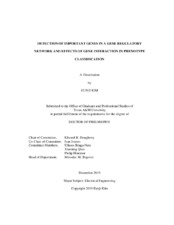| dc.description.abstract | The recent advancements in high-throughput technologies provide a wealth of information on gene expression patterns and gene-regulatory pathways. As a result, researchers in life sciences have an unprecedented opportunity for more sophisticated, integrative and holistic approaches to identify phenotype-associated (signaling) molecular markers. Biomarker discovery is one of the most important goals in bioinformatics; however, achieving this objective requires comprehensive analysis of gene expression profiles and gene-gene interactions that exist in high-dimensional data spaces. In this dissertation, we are concerned with critical issues that hinder biomarker discovery. In the first part, we focus on the effects of measurement platforms on ranking of genes. Analyzing gene expression patterns and selecting informative genes amounts to a supervised classification and feature selection. However, if the sample is small, error estimation is problematic and the performance of the feature-selection algorithm will be impacted by the performance of the error estimator. The problem is compounded by the fact that the accuracy of classification depends on the manner in which the phenomena are transformed into data by the measurement technology. Therefore, the first part of this dissertation is devoted to the study of the effects of the nonlinear transformation of the actual gene concentrations introduced by a sequencing machine on the feature-set ranking. The second part of this dissertation is devoted to canalizing genes which possess an ability to correct abnormal cellular processes for the purpose of biological robustness under genetic mutations or environmental perturbations. Despite their central role in gene regulatory networks (GRNs), the observation/detection of canalizing genes is often impeded because of their particular behavior. Therefore, we focus on inherent characteristics of canalizing genes and develop a quantitative framework that allows for the estimation of the power of canalizing genes in the context of Boolean Networks with perturbations (BNp s).
We also consider the problem of reducing the network complexity while preserving the distribution of the canalizing power of genes. We evaluate the stability of canalizing power under network reduction and proceed with the problem of selecting the relevant network features that allow for discriminating reducible networks which are determined by the degree of preservation of canalizing power. | en |


